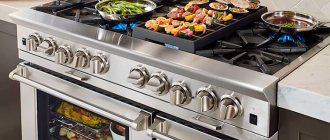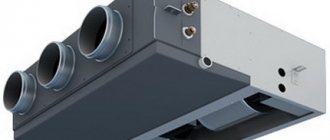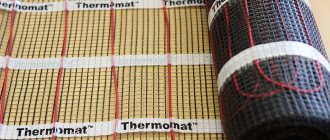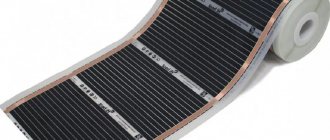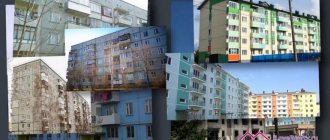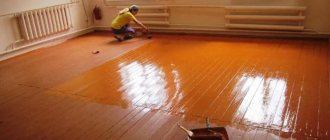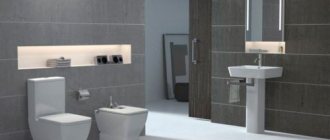A kitchen without a hood - what are the advantages and disadvantages
Despite the frantic pace of life in the modern world, every housewife still needs to spend a lot of time in the kitchen in order to prepare nutritious breakfasts, lunches and dinners for the whole family.
But the cooking process produces a lot of fat and odors.
In this regard, most people have a question: is a hood above the stove needed in the kitchen or is it still possible to somehow do without it, using a forced and natural ventilation system.
From January 1, 2022, a ban on connecting hoods to ventilation was introduced
Starting from January 1, 2022, control over compliance with SNiP standards has been strengthened, according to which, if your hood above a gas stove forcibly exhausts air into the general building system of an apartment building, then the hood must be dismantled or an alternative air outlet must be provided if this is allowed by the building design.
Let us immediately note that, based on these amendments, many facts have been registered when employees of inspection services demand that the hood be dismantled even if it does not violate current standards. In this article we will understand the essence of the issue and inform you what is an illegal connection and how to correct the situation if the hood is already installed.
Control
Hood control
There are mechanical or electronic controls. In the first case, buttons and switches on the panel help to use.
And the electronic model has a display and additional programs are available. functions (automatic shutdown, filter cleaning reminder, etc.). This, of course, increases the price of the device.
Basic requirements for hoods over gas stoves in apartment buildings
We would like to draw your attention to the fact that the new amendments apply only to equipment with forced air circulation installed above a gas stove and gas exhaust systems from gas boilers. If an exhaust hood without forced circulation is installed above the stove in your kitchen, then such a natural exhaust hood is not prohibited and can be connected to the general house ventilation duct.
The general requirements for a kitchen hood over a gas stove are as follows:
- The exhaust duct of the exhaust equipment should not completely block the general house ventilation duct. That is, it is necessary to install a combined grille, which will ensure the ventilation of the room when the hood is not working, as shown in the figure below.
- The exhaust power should not exceed the design capacity of the ventilation duct. In this case, the operation of an overly powerful hood will create a draft overturning effect in the common channel, which we will discuss below.
- It is not allowed to alter the ventilation duct without prior approval in the prescribed form from the control authorities. That is, you cannot arbitrarily expand the vent or move it to another location without approval.
Important! The resolution of the Russian Federation Committee on Construction and Residential Complexes No. 170, in paragraph 5.7.8, states that it is permissible to install hoods with forced ventilation and discharge into the general building ventilation system only for apartments on the upper floors, however, the requirements for exhaust power remain the same.
In modern new buildings, already at the design level, several main ventilation ducts with different accelerating shafts are provided. One channel serves exclusively for general ventilation of the room with natural air flow, the second for connecting an exhaust hood and is equipped with special exhaust equipment on the roof of the house. However, in old houses there is only one common channel with a diameter of the exhaust accelerating shaft of 22-24 cm and does not have forced exhaust, but works exclusively on natural circulation.
General information about the model
This ingenious integrated kitchen appliance fits perfectly into a modern cooking work area and matches any furniture. The design of this device will not leave anyone indifferent, and every time you prepare dishes you can get aesthetic pleasure.
As you can see from the photo, this model has excellent design and looks very stylish and modern.
The hob is equipped with four induction burners and is complemented by all sorts of useful functions. The surface of the device is covered with smooth, wear-resistant glass ceramics. This material is easy to clean from dirt and can withstand heavy loads.
The grille air vent cover is located in the central zone of the cooking device and rises 10 mm above the glass-ceramic surface.
General control of the stove and hood is carried out by a convenient touch panel with a clear indication. The operation of the hood can be adjusted either separately or together with the induction surface in a combined mode.
The device can be installed on the working surface of furniture in the standard way - with the panel supported on the tabletop, or it can be installed flush with the tabletop, in a milled groove 6.5 mm deep.
In what cases can you not connect a kitchen hood to general house ventilation?
It is prohibited to install a hood over a kitchen stove with forced ventilation and air exhaust into the common house channel with its complete blocking as shown in the figure below.
The adoption of such amendments was partly dictated by frequent natural gas explosions in apartment buildings. Special commissions that were created to investigate the causes of the explosions came to the conclusion that the explosion resulted in a large concentration of natural gas in the room due to faulty gas appliances.
An example of a citizen’s appeal to MOSGAZ regarding the installation of a hood
General house ventilation air ducts are designed to remove natural gas, which is lighter than air and accumulates in the upper part of the kitchen. However, installing hoods blocks these channels. As a result, the concentration becomes very high and the slightest spark leads not only to the ignition of the gas, but also to its rapid expansion in a limited space with great destruction.
In addition, according to the results of the inspection, it turned out that almost all hoods significantly exceed the capacity of the channel in power and this causes the effect of the draft overturning.
The oven is not under the hood.
I'm planning a kitchen, I want to put a built-in oven in a counter, but it will be far from the hood. Is this very critical? Besides, we don’t have doors to the kitchens.
I'm afraid that the smell of food will be throughout the apartment.
Vladimir KozhinForeman Evgenia AkimovaDesigner Olga RumovaDesigner
I don’t notice any odors from the oven, even though we use it every day. All the smells are from the cooking room. The oven is in a cabinet separate from the hob, no problem.
Other questions on this topic
- Where to stop!!!??????
I want to hear your comments! We did a kitchen project, but I doubt it will be worse in real life! I doubt the gloss! Do you think the kitchen in the third photo will match this furniture? - Help with the color of furniture and curtains in the guest kitchen-studio
Dear designers and just kind people, what can you advise? This is a studio kitchen. The counter will be closed with lockers. To the left of the counter is a TV. Opposite the purple walls of the kitchen, top is vanilla gloss, bottom is lime gloss. The walls are pearl color. The ceiling is white… - What qualities are best to choose kitchen facades?
I would like there to be the maximum combination of price and quality. The variety of materials and textures for kitchen facades is amazing. What is better to choose from this variety? - Is it convenient to have a dishwasher and washing machine nearby?
We drew up a kitchen design in IKEA: sink, built-in, built-in. Does anyone have this arrangement? Can I have a photo? - How to place kitchen furniture and a sofa on 14 m?
Good afternoon, forum users! Please tell me how to place a kitchen with a full-fledged sleeping place for daily use in the presented version of the kitchen layout (14 m2). The kitchen is supposed to accommodate: a refrigerator, a dishwasher,…
ideas.vdolevke.ru
What is the pull-over effect?
The effect of draft overturning is called a complete stop in the operation of the ventilation duct or its operation in an unnatural mode, which is not provided for by the design. Traction overturning occurs mainly due to violations of the channel use modes.
Old apartment buildings with common building ventilation ducts are designed to operate according to a natural ventilation scheme, according to which the air flow into the room is carried out through window openings, the air in the room heats up and loses density as it rises. Next, it enters the ventilation duct right under the ceiling and is removed through the accelerating main duct as shown in the figure below. Such a system cannot work without ensuring a flow of fresh air from the apartment.
By closing the exhaust duct, when the hood is not working, air circulation does not occur and carbon dioxide accumulates in the room or natural gas concentrates if there are leaks. The widespread installation of hoods with blocked ducts leads to the fact that the draft in the accelerating duct decreases or disappears altogether and the exhaust air masses no longer exit through the roof.
If it’s warm outside, then the draft practically stops, and you begin to smell what the neighbors below are cooking, since the speed in the acceleration channel is not enough to bring them outside. If it’s cold outside, then the cold air from the outside, through the outlet on the roof of the house, presses on the acceleration channel, that is, it strives to replace the warm air. This leads to reverse draft and cold air begins to blow from the ventilation, which then condenses in the apartment and leads to fogging of the windows, increased humidity and the appearance of mold not only in the apartment, but also in the air duct itself.
Excerpt from SNiP for multi-apartment buildings.
Selection rules
You should not choose the most expensive and largest model, but the optimal one. To do this, take into account such features.
- Dimensions - the width of the working surface of the panel should be equal to the width of the slab or be larger - up to 10 cm. Reducing the area significantly worsens the quality of air filtration. The most popular dimensions are considered to be 60*90 cm. But if the slab has non-standard dimensions, you need to choose a model in accordance with them.
- Power is the main parameter . The range of indicators for the hood is 150–350 W. The power of the appliance is selected according to the volume of the kitchen. After all, soot and steam do not concentrate near the stove, so you need to clean a fairly large volume of air. It makes no sense to buy a model more powerful than required. It uses more electricity and creates noise with the same cleaning effect.
- Productivity – calculated based on cooking time and intensity. If simple dishes are prepared on the stove, mainly boiling and baking, appliances with a capacity of up to 200–300 m³/hour are sufficient. If cooking takes several hours and includes frying, a more powerful hood is needed - 300–400 m³/hour. For experienced cooks and large families, you will need a model with maximum performance – 500–600 m³/hour.
- Noise level – even a compact hood with a filter produces some noise. And this greatly affects the level of comfort. The optimal solution is considered to be hoods at 45 dB. If the room is larger, the parameter can reach 55 dB.
- Operating conditions – in a small kitchen with already installed furniture, a built-in flat hood is installed. For island kitchens, purchase models that are mounted on the ceiling.
Also, when choosing, take into account the presence of additional functions: touch screen, remote control, the ability to regulate the intensity of work.
Checking compliance with new requirements
Initially, responsibility for verifying compliance with the new requirements was assigned to the State Traffic Safety Inspectorate. But employees of the State Fire and Rescue Service are physically unable to check everyone during regular rounds of their department, therefore it is planned to involve other services in this, in particular employees of gas companies and technical staff of management companies. Their tasks will include checking compliance with safety standards, checking the operation of ventilation ducts and identifying violations.
If violations are detected, employees will be issued a warning with an order to eliminate the violation as soon as possible. Particularly thorough inspection will be carried out on those houses from which complaints from the residents themselves come.
What to do if the hood is already installed in violation of the new standards?
- The most optimal solution to the problem is to install a special grille, which has a hole for connecting the pipe from the hood and at the same time a grille for natural air circulation even when the hood is not working. Picture above.
- Study the characteristics of your hood model. Modern hoods have a universal design that provides for both air exhaust through a pipe to the outside and the installation of special carbon filters that retain odors and clean the air. If it is possible to install filters, then install them and remove the pipe altogether.
- Installation of a separate channel. This work involves making a hole in the outer wall of the building specifically for the hood. We remind you that this work cannot be carried out independently. This requires special permits and a certified specialist.
- Exiting the hood through the window. This option is possible if the hood itself is not far from the window and the design of the window itself has a window, which is not the case in most plastic windows. A special grille is installed in the window and the outlet duct from the hood is connected.
- Replacement of gas stove. According to the new requirements, if you have an electric stove installed, then you are not violating any rules and there can be no claims against you, even if you have completely closed the ventilation duct.
Price
Now is the time to talk about the cost of such a kitchen element.
On the household appliances market, Italian developers from Elica presented a series of hobs with a built-in hood under the general name NIKOLATESLA, consisting of models that differ in design and characteristics. Prices for some devices presented in the comparison table are taken from the official Russified website of the company
| № | Name | Price |
| 1 | Elica NIKOLATESLA BL/A/83 | RUB 155,490.00 |
| 2 | Elica NIKOLATESLA BL/F/83 | RUB 165,790.00 |
| 3 | Elica NIKOLATESLA HP BL/A/83 | RUB 207,290.00 |
| 4 | Elica NIKOLATESLA HP BL/F/83 | RUB 217,690.00 |
| 5 | Elica NIKOLATESLA FLAME GR/A/88 | RUB 145,490.00 |
| 6 | Elica NIKOLATESLA FLAME BL/F/88 | RUB 156,290.00 |
| 7 | Elica NIKOLATESLA PRIME BL/A/83 | RUB 118,590.00 |
| 8 | Elica NIKOLATESLA PRIME BL/F/83 | RUB 129,390.00 |
| 9 | Elica NIKOLATESLA SWITCH WH/A/83 | RUB 279,890.00 |
| 10 | Elica NIKOLATESLA SWITCH BL/F/83 | RUB 269,490.00 |
We remind you that the combination of letters BL, WH or GR indicates the color of the hob. The manufacturer offers a choice of colors - black (color designation in the article BL), white (color designation in the article WH), gray (color designation in the article GR).
Let us also repeat that the marking following the color indicates the configuration of the device. Letter F – version for recirculation, equipped with carbon filters and everything necessary to connect the recirculation mode. Letter A – version for air exhaust; on the website you can purchase all the necessary accessories for installing the exhaust duct.
| vendor code | Photo | Price |
| KITO121007 | RUR 2,790 | |
| KITO120996 | RUB 1,890 | |
| KITO121003 | 790 R | |
| KITO121006 | RUB 3,590 | |
| KITO120991 | RUB 3,890 | |
| KITO121001 | 990 R | |
| KITO121004 | RUB 3,090 | |
| KITO121005 | 890 R | |
| KITO121008 | RUB 2,190 | |
| KITO121010 | RUB 15,290 | |
| KITO121009 | RUR 19,890 |
Now about the cost of filters. If for the grease filter to work it is enough to simply wash it, then filters for removing odors must be replaced. Such filters are assembled into an odor-collecting battery consisting of 4 pieces. The price is for the complete set.
| vendor code | Photo | Price |
| KIT0147855 | RUB 9,090 | |
| KIT0120952 | RUR 11,990 |
The manufacturing method of carbon filters differs, so the service life of these elements is different.
The first - synthetic filter - consists of synthetic fibers containing activated carbon granules. This element is disposable and cannot be restored; the average service life is 1 year.
The second is a ceramic filter - a ceramic container filled with activated carbon. It is able to restore its properties; to do this, it is enough to place it in the oven at 200 degrees for 45 minutes every 2-3 months. The service life of the ceramic filter is up to 5 years.
What to do now: prohibition on connecting the hood from the stove
It will come as a surprise to many that not all apartments can connect a kitchen hood to a common ventilation duct. The issue is especially acute in old houses and new housing stock where gas stoves are used. Starting from January 1, 2019, new amendments to the Fire Safety Rules came into force. It is prohibited to connect exhaust devices to the natural ventilation system.
Management companies argue and warn homeowners about the ban on connecting hoods, citing SNiP (building codes and regulations) and GOST from 2003, but previously no one monitored the implementation of the rules. After a series of sad events related to gas explosions in multi-storey buildings, control has been significantly strengthened. At stake is not only the safety of the building, but also the lives of people.
Why does everyone put it on, but we can’t?
In old houses, the issue of the hood was never raised, so everyone installed the device and connected it to the ventilation shaft to get rid of cooking odors. Also, the absence of problems during installation is explained by the fact that individual channels for air exchange were used in aging housing stock. Each apartment had its own shaft, to which none of the neighbors could connect.
In modern houses, especially in multi-storey new buildings, a common ventilation shaft is used to speed up construction and standardize air exchange. The design provides branches for each apartment and one common air outlet. If the shaft is massive, it has several channels isolated from each other. This is required to separate the ventilation of the bathroom, toilet, kitchen, etc.
It is important to understand that the laws are intended exclusively for apartments where gas stoves are used. The fact is that the presence of a hood impairs the functioning of natural ventilation and gas can accumulate in the apartment. Without an influx of fresh air, the room becomes a reservoir for a hazardous substance, and when a critical concentration is reached, the situation becomes explosive. The options “keep the window open” or “the room is constantly ventilated” do not mitigate the situation, because it is impossible to constantly control the ventilation of the apartment. Air exchange must be natural and correct!
If all your neighbors are installing a hood, don't follow their example. For failure to comply with the rules, the apartment owner will be fined and will be forced to dismantle the device. Don’t follow stupid examples, because this is not about breaking the rules, but about the safety of life.
Tips for use
- Keep the device clean and wipe it free of dust and grease after each use.
- Do not turn off the device immediately after cooking, as steam particles can spread throughout the kitchen faster than the device can absorb them. Therefore, you need to leave the hood running for a few more minutes so that it draws in all the fumes.
- Replace carbon filters regularly - at least 2 times a year.
What options are suitable?
If you already have a hood installed in your kitchen or you were in the process of choosing a device, don’t be discouraged. It is possible and necessary to ventilate the room, just follow simple installation tips. List of recommendations that do not violate current rules:
Refusal of the gas stove. The maximum load on the electrical line of the apartment must satisfy the requirements of the electric stove. All you need to do is install the hob and you won’t have to turn off the hood. The rules apply exclusively to premises with gas equipment. Use charcoal hoods. They have a special filter that cleans the air from unpleasant odors and does not allow dirt to pass through. Installation is no different from a conventional device, except for the unnecessary connection to the ventilation shaft.
An example of a hood without connection to a ventilation duct. It forces air through filters.
Expansion of the ventilation duct. When making repairs, most people use a cover plate that only involves connecting the hood. To ensure natural air flow, you can expand the channel and use a special grille, which guarantees constant air exchange.
The hood is connected through a separator and does not interfere with ventilation.
Exhaust air through the window. This option is not suitable for everyone, since the exhaust device may be located far from the windows. This also affects the design of the room. If desired, you can make a special hole in the window or replace the glass with durable plastic to cut out a ventilation grille in it. Connection to the street. With the permission of the responsible authorities, you can make a separate hole in the wall and lead the air duct to the street. The process is prohibited from being carried out independently, as this may violate the operating rules and fire safety of the building. You should seek help from specialists.
In conclusion, I would like to note that safety should come first. Don't follow the example of neighbors who break the rules, but rather report known incidents to the management company. Failure to comply with norms seems harmless only until something irreparable happens. There are many alternatives for kitchen ventilation that don't put anyone's life at risk. Before installing the hood, be sure to read our article about installing a kitchen hood for a stove.
Self-installation
A hood is not the most complicated device, so if you have a little experience and a set of necessary tools, it is quite possible to install it yourself. Self-installation is a great opportunity to save on the services of specialists.
Installation of a hood attached to the bottom of the cabinet
Hanging models are attached directly to the bottom shelf of the cabinet. Installation is simple, installation is carried out using self-tapping screws and a screwdriver. Since connecting the air duct to the recirculating device is not required, the installation ends by connecting it to the electrical network.
Installation of a hood in a wall cabinet
Installing a hood into a cabinet yourself requires certain carpentry skills. For a new set, the device is purchased at the furniture design stage. In order for it to fit into an already used hanging cabinet, it is necessary that the dimensions of the hood correspond to the internal dimensions of the case.
To work you will need:
- jigsaw, you can also use a manual one;
- hacksaw for wood;
- pencil;
- screwdriver (preferably a screwdriver);
- awl;
- construction angle, tape measure;
- clamps.
Installation steps:
- First of all, you need to free the cabinets from the facades, and not only the specific cabinet for the hood, but also the adjacent drawers. Next, remove the cabinet and fasten the adjacent cases together with clamps. Do not skip this point - the boxes may fall and be damaged.
- We unscrew the bottom shelf and apply it to the upper plane of the exhaust device. We outline the outline of the air duct and the holes for the outlet of the wire with a plug to connect the device to the network. Cut out the marked holes.
- We insert the hood into the housing and mark the upper boundaries of the device. We fasten the bottom shelf along the marked lines. We drill 4 holes in it.
You can ensure exact alignment of the fastening points with the holes using a stencil.
We fix the hood inside the cabinet and install the air duct. We use it to connect the ventilation hole and the system. We install shelves and fronts. It is worth checking the functionality of the equipment before installing the facades.
Installation of a hood with an air duct
The installation procedure for such a hood includes:
- fixing the hood;
- development of air duct and electrical wiring diagrams;
- box fitting;
- installation of the box using sealant.
The air duct is assembled from a plastic box or made of aluminum corrugation. The first option is stronger, more aesthetically pleasing and more reliable. Therefore, it is worth giving preference to it. Plastic is easy to saw and joined with special elements. Additional strength is added to the joints using sealant. Corrugation also has its advantages - its flexibility allows you to lay the air duct along a curved path.
From January 1, 2022, a ban on connecting hoods to ventilation was introduced
Starting from January 1, 2022, control over compliance with SNiP standards has been strengthened, according to which, if your hood above a gas stove forcibly exhausts air into the general building system of an apartment building, then the hood must be dismantled or an alternative air outlet must be provided if this is allowed by the building design. Let us immediately note that, based on these amendments, many facts have been registered when employees of inspection services demand that the hood be dismantled even if it does not violate current standards. In this article we will understand the essence of the issue and inform you what is an illegal connection and how to correct the situation if the hood is already installed.
Basic requirements for hoods above gas stoves in apartment buildings We would like to draw your attention to the fact that the new amendments apply only to equipment with forced air circulation installed above a gas stove and gas exhaust systems from gas boilers. If an exhaust hood without forced circulation is installed above the stove in your kitchen, then such a natural exhaust hood is not prohibited and can be connected to the general house ventilation duct.
The general requirements for a kitchen hood over a gas stove are as follows:
The exhaust duct of the exhaust equipment should not completely block the general house ventilation duct. That is, it is necessary to install a combined grille, which will ensure the ventilation of the room when the hood is not working, as shown in the figure below. The exhaust power should not exceed the design capacity of the ventilation duct. In this case, the operation of an overly powerful hood will create a draft overturning effect in the common channel, which we will discuss below. It is not allowed to alter the ventilation duct without prior approval in the prescribed form from the control authorities. That is, you cannot arbitrarily expand the vent or move it to another location without approval. Important! The resolution of the Russian Federation Committee on Construction and Residential Complexes No. 170, in paragraph 5.7.8, states that it is permissible to install hoods with forced ventilation and discharge into the general building ventilation system only for apartments on the upper floors, however, the requirements for exhaust power remain the same. In modern new buildings, already at the design level, several main ventilation ducts with different accelerating shafts are provided. One channel serves exclusively for general ventilation of the room with natural air flow, the second for connecting an exhaust hood and is equipped with special exhaust equipment on the roof of the house. However, in old houses there is only one common channel with a diameter of the exhaust accelerating shaft of 22-24 cm and does not have forced exhaust, but works exclusively on natural circulation.
What are the dangers of incorrect height?
If the height of the hood above an electric or gas stove is chosen incorrectly, the user may face unpleasant consequences. In particular, if the hood is located too low, the following problems may occur:
- Constant overheating of the device;
- possible ignition of deposits accumulated on the filter;
- Difficulties in servicing the appliance and cooking due to its inconvenient location.
Negative consequences also occur if the exhaust system is located too high. They are listed here:
- Highly installed units will either suck in air much worse or will be forced to work at the limit of their capabilities;
- Such devices are inconvenient to maintain due to their high location.
An alternative to a grounded outlet may be a 16 A residual current circuit breaker. Such a device must be installed in the distribution board.
